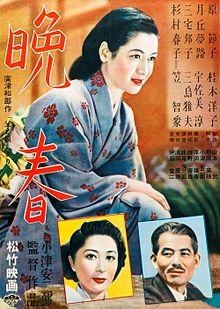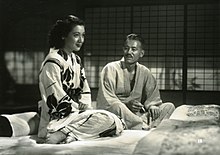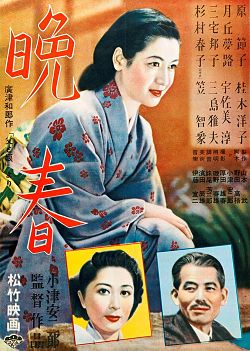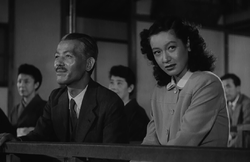Setsuko HaraSetsuko Hara (原 節子 Hara Setsuko, June 17, 1920 – September 5, 2015) was a Japanese actress. In the West, she is best known for her performances in Yasujirō Ozu's films Late Spring (1949) and Tokyo Story (1953), although she had already appeared in 67 films before working with Ozu.
Late Spring (晩春 Banshun) is a 1949 Japanese drama film, directed by Yasujirō Ozu and produced by the Shochiku studio. It is based on the short novel Father and Daughter (Chichi to musume) by the 20th-century novelist and critic Kazuo Hirotsu, and was adapted for the screen by Ozu and his frequent collaborator, screenwriter Kogo Noda Allied Powers' Occupation of Japan and was subject to the Occupation's official censorship requirements. It stars Chishū Ryū, who was featured in almost all of the director’s films, and Setsuko Hara Early Summer (Bakushu, 1951) and Tokyo Story (Tokyo Monogatari, 1953)—in each of which Hara portrays a young woman named Noriko, though the three Norikos are distinct, unrelated characters, linked primarily by their status as single women in postwar Japan. Late Spring belongs to the type of Japanese film known as shomingeki, a genre that deals with the ordinary daily lives of working class and middle class people of modern times. The film is frequently regarded as the first in the director’s final creative period, "the major prototype of the [director's] 1950s and 1960s work." These films are characterized by, among other traits, an exclusive focus on stories about families during Japan's immediate postwar era, a tendency towards very simple plots and the use of a generally static camera. Late Spring was released in September 1949 to critical acclaim in the Japanese press. In the following year, it was awarded the prestigious Kinema Junpo critics' award as the best Japanese production released in 1949. In 1972, the film was commercially released in the United States, again to very positive reviews. Late Spring has been referred to as the director's "most perfect" work, as "the definitive film of Ozu's master filmmaking approach and language" and has been called one of the most perfect, most complete, and most successful studies of character ever achieved in Japanese cinema." In the 2012 version of Sight & Sound's decennial poll of "The Greatest Films of All Time", published by the British Film Institute (BFI), Late Spring appears as number 15, behind Ozu's own Tokyo Story at number 3. Plot Professor Shukichi Somiya (Chishu Ryu), a widower, has only one child, a twenty-seven-year-old unmarried daughter, Noriko (Setsuko Hara), who takes care of the household and the everyday needs—cooking, cleaning, mending, etc.—of her father. on a shopping trip to Tokyo, Noriko encounters one of her father's friends, Professor Jo onodera (Masao Mishima), who lives in Kyoto. Noriko knows that onodera, who had been a widower like her father, has recently remarried, and she tells him that she finds the very idea of his remarriage distasteful, even "filthy." onodera, and later her father, tease her for having such thoughts. Shukichi's sister, Aunt Masa (Haruko Sugimura), convinces him that it is high time his daughter got married. Noriko is friendly with her father’s assistant, Hattori (Jun Usami), and Aunt Masa suggests that her brother ask Noriko if she might be interested in Hattori. When he does bring up the subject, however, Noriko laughs: Hattori has been engaged to another young woman for quite some time. Undaunted, Masa pressures Noriko to meet with a marriageable young man, a Tokyo University graduate named Satake who, Masa believes, bears a strong resemblance to Gary Cooper. Noriko declines, explaining that she doesn't wish to marry anyone, because to do so would leave her father alone and helpless. Masa surprises Noriko by claiming that she is also trying to arrange a match between Shukichi and Mrs. Miwa (Kuniko Miyake), an attractive young widow known to Noriko. If Masa succeeds, Noriko would have no excuse. At a Noh performance attended by Noriko and her father, the latter smilingly greets Mrs. Miwa, which triggers Noriko's jealousy. When her father later tries to talk her into going to meet Satake, he tells her that he intends to marry Mrs. Miwa. Devastated, Noriko reluctantly decides to meet the young man and, to her surprise, has a very favorable impression of him. Under pressure from all sides, Noriko consents to the arranged marriage. The Somiyas go on one last trip together before the wedding, visiting Kyoto. There they meet Professor onodera and his family. Noriko changes her opinion of onodera's remarriage when she discovers that his new wife is a nice person. While packing their luggage for the trip home, Noriko asks her father why they cannot simply stay as they are now, even if he does remarry – she cannot imagine herself any happier than living with and taking care of him. Shukichi admonishes her, saying that she must embrace the new life she will build with Satake, one in which he, Shukichi, will have no part, because "that’s the order of human life and history." Noriko asks her father’s forgiveness for her "selfishness" and agrees to go ahead with the marriage. Noriko’s wedding day arrives. At home just before the ceremony, both Shukichi and Masa admire Noriko, who is dressed in a traditional wedding costume. Noriko thanks her father for the care he has taken of her throughout her life and leaves in a hired car for the wedding. Afterwards, Aya (Yumeji Tsukioka), a divorced friend of Noriko’s, goes with Shukichi to a bar, where he confesses that his claim that he was going to marry Mrs. Miwa was a ruse to persuade Noriko to get married herself. Aya, touched by his sacrifice, promises to visit him often. Shukichi returns home alone. 晩春 (映画)
『晩春』(ばんしゅん)は、1949年(昭和24年)に公開された小津安二郎監督の日本映画。 1949年度の「キネマ旬報ベスト・テン」の日本映画部門で1位に輝いている。日本国外でも非常に高い評価を得ており、英国映画協会(BFI)選定の2012年版「批評家が選ぶ史上最高の映画トップ50」で15位に輝いている。 解説娘の結婚を巡るホームドラマを小津が初めて描いた作品であり、その後の小津作品のスタイルを決定した。小津が原節子と初めてコンビを組んだ作品でもある。なお、本作および後年の『麦秋』(1951年)、『東京物語』(1953年)で原節子が演じたヒロインはすべて「紀子」という名前であり、この3作品をまとめて「紀子三部作」と呼ぶこともある。 딸의 결혼을 둘러싼 홈 드라마를 오즈가 처음 그린 작품이며, 다음의 오즈 작품의 스타일을 결정했다. 오즈가 하라 세츠코와 처음 콤비를 이룬 작품이기도하다. 덧붙여 본작과 후년의 "보리"(1951 년), 「동경 이야기」(1953 년) 에서 하라 세츠코가 연기한 주인공은 모두 "노리코"라는 이름이며,이 3 작품을 정리해 「노리코 3부 작」이라고 부르기도한다. 原作は、作家の広津和郎が熱海に滞在中に書いた小説『父と娘』である。小津は本作以前にもホームドラマを数多く手掛けているが、結婚する娘と父の関係を淡々とした日常の中に描いたのは、本作が初となる。戦後2作目となる前作『風の中の牝雞』(1948年)では、戦後の荒廃した世相を夫婦の危機に反映させた意欲作だったにもかかわらず観客の拒絶にあい、失敗作と認めざるを得なかった. 小津にとって、一転して娘の結婚をめぐるホームドラマという普遍的な題材は興味を引くものだった。 원작은 작가의 카즈오 히로츠가 아타미에 머무는 동안 쓴 소설 '아버지와 딸'이다. 오즈는 본작 이전에도 홈 드라마를 많이 다루고 있지만, 결혼하는 딸과 아버지의 관계를 담담한 일상 속에 그린 것은, 본작이 처음이다. 전후 2 번째 작품이 되는 전작 「바람 속의 암닭 "(1948 년)에서는 전후의 황폐한 세태를 부부의 위기에 반영시킨 의욕작이었음에도 불구하고 관객의 거절에는 실패작을 인정하지 않을 수 없었다. 오즈에게, 일전하여 딸의 결혼을 둘러싼 홈 드라마라는 보편적인 주제는 관심을 끄는 것이었다. 監督を承諾した小津は、『箱入娘』(1935年)以来14年ぶりにコンビを組む野田高梧と約1年をかけて脚本を執筆し、映画化にのぞんだ。野田とのコンビによる約1年間の脚本共同執筆は、以後、小津の遺作となる『秋刀魚の味』(1962年)まで続くこととなるが、同時に、原節子とのコンビ、笠智衆(りゅうちしゅう) 演じる初老の父親が娘を嫁にやる悲哀など、いわゆる小津映画のスタイルも、すべて本作で初めて確立された。また、ローアングルで 切り返す(きりかえす) 独特な人物ショットの反復や、空舞台と呼ばれる風景カットの挿入などの映像スタイルは、必ずしも本作で初めて採用されたものではないが、以後遺作まで反復される娘の結婚というドラマと連動することによって、その説話的主題を明確にする映像スタイルとして機能することになる。 감독을 수락한 오즈는 "순진한 처녀(금지옥엽 키운 딸) '(1935 년) 이후 14 년만에 콤비 노다 코우고와 약 1 년에 걸쳐 각본을 집필하고 영화화에 임하고 있었다. 노다와의 콤비에 의한 약 1 년간의 각본 공동 집필은 이후 오즈의 유작인 '꽁치의 맛'(1962 년)까지 계속하게되지만, 동시에 하라 세츠코와의 콤비 류치슈가 연기한 초로의 아버지가 딸을 시집보내는 비애 등 이른바 오즈 영화의 스타일도 모든 본작에서 처음 확립되었다. 또한 로우 앵글로 역습(반격)하는 독특한 인물 샷의 반복이나 빈 무대라는 풍경컷 삽입 등의 영상 스타일은 반드시 본작에서 처음으로 채용된 것은 아니지만, 이후 유작까지 반복되는 딸의 결혼이라는 드라마와 연동하여 그 설화적 주제를 명확히하는 영상 스타일로 기능하게 된다. 占領下の日本において、鎌倉や京都の日本的な風景や能舞台などの日本文化をフィルムに焼きつけ、その中で描かれる余分な要素を一切排除した結婚ドラマは、公開当時、そこに日本的なものの復権を感じ取る観客層と、戦後の現実からの逃避とみなす観客層の二つに分かれ、評価は賛否両論となった。しかし、あえて普遍的な人間ドラマをありのままに描こうとする小津の姿勢は、後にテレビ時代に入って本格化するホームドラマの製作スタイルに多大な影響を与えることとなった。一方、映画で語られる人間の感情を描ききるためには映画文法を踏み外すことも辞さない小津の姿勢や、感情を映像化しようとするスタイルは、後に世界中の映画評論家やファンの議論の的となり、小津作品の中でも今なお最も語られることの多い一本である。 점령하의 일본에서 가마쿠라와 교토의 일본적인 풍경과 노(能 のう) 무대 등 일본 문화를 필름에 담아, 그 안에서 그려지는 여분의 요소를 일체 배제하고 결혼 드라마는, 개봉 당시, 거기에 일본적인 것의 복권을 느낄 관객층과 전후의 현실에서 도피해 보는 관객층의 두 가지로 나누어 평가는 찬반 양론으로 되었다. 그러나 굳이 보편적인 인간 드라마를 그대로 그리려고 하는 오즈의 자세는, 나중에 텔레비전 시대에 들어 본격화하는 홈 드라마의 제작 스타일에 큰 영향을 주게되었다. 한편, 영화에서 말하는 인간의 감정을 그려내는 데 영화 문법을 벗어나는 것도 불사하고 오즈의 자세와 감정을 영상화하려고 하는 스타일은 후에 세계 영화 평론가와 팬들의 논의의 대상이되고, 오즈 작품 중에서도 여전히 가장 거론되는 것이 많은 하나이다. 本作は、リンゴの皮を剥いていた父親がうなだれるシーンで終わるが、当初小津は父親役の笠智衆に「皮を剥き終えたら慟哭するように」と指示を出していた。大仰な演技を嫌っていた小津からそのような要求を受けたことに驚いた笠は「それはできない」と答え、小津も無理にやらせようとはしなかったため変更になった。小津の指示通りに演技をしていた笠が、唯一小津に異を唱えたのがこのシーンである。笠は後に、小津自身も迷っていたのかもしれず、また自分にそういう演技はできないことを小津も分かっていだのだろうとした上で「できるできないは別にして、とにかくやってみるべきだった。監督に言われたことはどんなことでもやるのが俳優の仕事」と語っている。 본작은 사과 껍질을 벗기고 그의 아버지가 고개를 떨구는 장면으로 끝나는, 당초 오즈는 아버지 역의 류 치슈에 "껍질 벗기기 끝나면 통곡하라"고 지시했다. 호들갑 연기를 싫어하는 오즈에게서 그런 요구를 받은 것에 놀란 류 치슈는 "그것은 알 수 없다"고 대답했고, 오즈도 억지로 시키려고는하지 않았기 때문에 변경되었다. 오즈의 지시대로 연기를 하고 있던 류 치슈가, 유일하게 오즈에 이의를 제기 한 것이 이 장면이다. 류치슈는 이후 오즈 자신도 헤매고 있었을지도 모르고, 또 자신에게 그런 연기는 할 수없는 것을 오즈도 잘 알고 있었을 것이라고 한 다음 "할 수 없는 것은 별도로 하고 어쨌든 해 보는 것이었다. 감독이 말한 것은 어떤 일이라도 해주는 것이 배우의 봉사 " 라고 말했다. 劇中の能の演目は小津が能楽師(のうがくし)の金春惣右衛門に相談し、本作が恋物語であることから、金春が『杜若』を提案し、採用された。『杜若』はカキツバタの精の話で、『伊勢物語』第九段に出てくる 在原業平(ありわらのなりひら) のカキツバタの和歌 (遠く都に置いてきた妻を想う歌)を下敷きにしたもの。クレジットには「杜若 戀之舞」とあるが、「戀之舞」の部分は編集時にカットされた。シテを演じているのは梅若万三郎[要曖昧さ回避]。 극중 노우(能のう)의 상연목록은 오즈가 노가쿠사 콘하루 소우에몬과 상담 , 본작이 사랑 이야기이기 때문에, こんぱる가 「제비 붓꽃」을 제안하고 채택되었다. 「제비 붓꽃」은 제비 붓꽃의 요정 이야기 "伊勢物語"제 9 단에 나오는 아리와라노 나리히라의 제비 붓꽃의 단가(와카) (멀리서울에두고 온 아내를 생각하는 노래)를 밑받침한 것。 ,引用 에는 '제비 붓꽃 연무"도 있지만,"戀之舞 "부분은 편집 할 때 컷되었다. 仕手를 연기하고있는 것은 梅若 万三郎(うめわかまんざぶろう) 。 * 杜若 ; 연자화, 산강(山姜), 산생강,두향, 제비 붓꽃(?) * いせものがたり [伊勢物語] ;平安へいあん시대 전기의 和歌わか로 된 이야기. 사랑과 우정에 관한 내용을 담았음 * 在原業平(ありわらのなりひら;일본의 와카 시인. 헤이안 시대[平安時代] 전기부터 중기에 걸쳐 활동했다. 헤이조[平城] 덴노의 아들 아보[阿保] 왕자의 다섯째 아들이다. 826년 아리와라 성(姓)을 하사받았다. * クレジット: 크레디트, 신용,차관,引用 ,引証, 引例 *Cité (シテ); して [仕手], あらすじ 早くに妻を亡くし、それ以来娘の紀子に面倒をかけてきた大学教授の曾宮周吉は、紀子が婚期を逃しつつあることが気がかりでならない。周吉は、妹のマサが持ってきた茶道の師匠・三輪秋子との再婚話を受け入れると嘘をついて、紀子に結婚を決意させようとするが、男が後妻を娶ることに不潔さを感じていた紀子は、父への嫌悪と別れの予感にショックを受けてしまう。マサの持ってきた縁談を承諾した紀子は、周吉と京都旅行に出かけ再度心が揺れるが、周吉に説得されて結婚を決意する。紀子が嫁いだ晩、一人家に残る心を決めた周吉は、人知れず孤独の涙を流す。 일찍 아내를 잃고 그 이후 딸 노리코 돌봄에 생을 걸었던 대학 교수의 曾宮 周吉는 노리코가 혼기를 놓치게 되는 것이 걱정이 되지는 않는다. 周吉는 여동생 마사가 가져온 다도 선생 · 미와 아키코와의 재혼 이야기를 받아들이는 거짓말을 하고 노리코에 결혼을 결심 시키려고하지만, 사람이 후처를 취하는 일에 불결함을 느낀 노리코는, 아버지에 대한 혐오와 이별의 예감에 충격을 받고 만다. 마사의 가져온 혼담을 승낙한 노리코는 周吉와 교토 여행을 떠나 다시 마음이 흔들리지만, 周吉에 설득되어 결혼을 결심한다. 노리코가 시집간 밤 혼자 집에 남아 마음을 결정한 周吉는 남몰래 외로움의 눈물을 흘린다. | ||||||||||||||||||||||||||||||||||||||||||||||||||||||||||||||||||||||
日本女優の第1位 「永遠の処女」 |
永遠の聖女-原 節子
生涯、一度も結婚しなかった。
'Beautiful People' 카테고리의 다른 글
| 최초의 여류비행사 박경원(朴敬元) (0) | 2020.04.17 |
|---|---|
| 靑燕 박경원 1 (0) | 2020.04.17 |
| 한국 최초 여류비행사 권기옥 (0) | 2020.04.17 |
| 조선 최초 여류비행사 (0) | 2020.04.17 |
| 永遠の聖女-原節子 (0) | 2020.04.16 |





